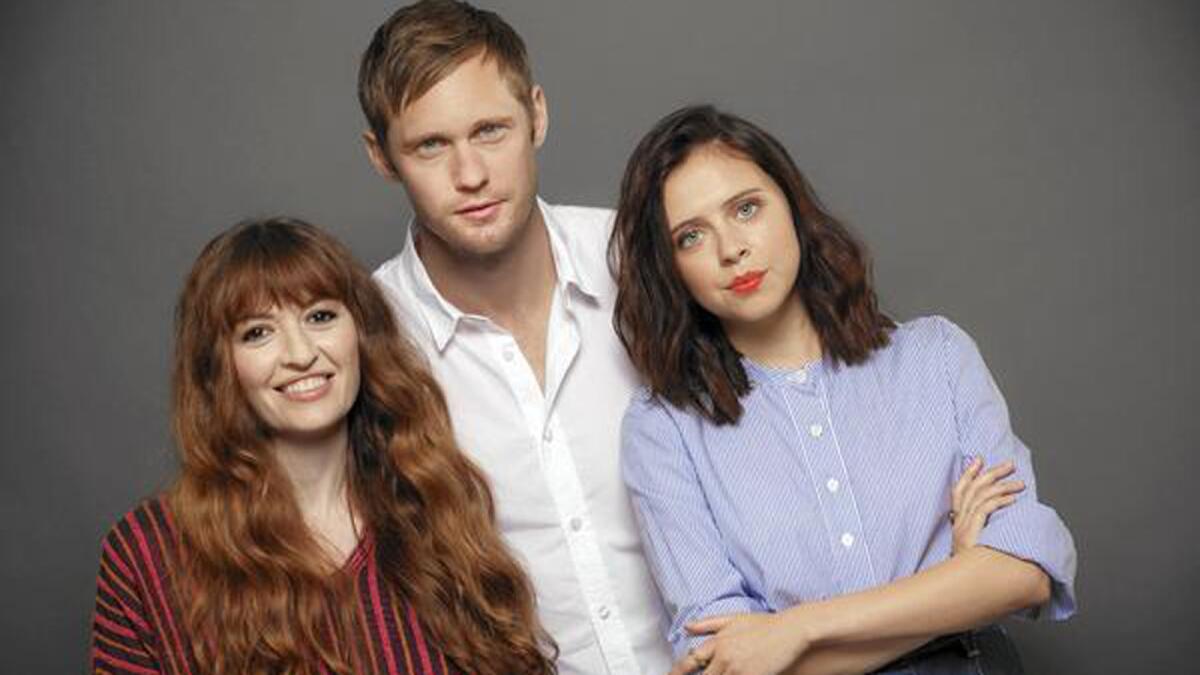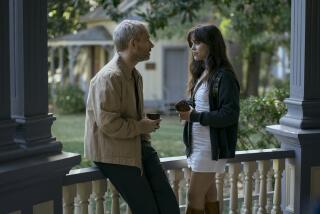‘The Diary of a Teenage Girl’ is a rare film that explores female sexuality without judgment

Marielle Heller, left, directed Alexander Skarsgard as 35-year-old Monroe and Bel Powley as 15-year-old Minnie in “The Diary of a Teenage Girl.”
- Share via
Looking at someone else’s diary is deeply personal, a bit shocking and charged with the feeling of seeing something for the first time. “The Diary of a Teenage Girl” generates a similar response as it opens the book on adolescent female sexuality with a raw, intimate, emotional candor rarely depicted on screen.
Set in San Francisco in 1976, as the Patty Hearst bank robbery trial plays out on TV and lingering post-hippie vibes mingle with burgeoning punk bluntness, the film opens with 15-year-old Minnie Goetze exclaiming excitedly to her tape recorder diary that she just had sex for the first time. As it turns out, her partner was 35-year-old Monroe, the boyfriend of her mother, Charlotte. As their obviously doomed affair plays itself out, Minnie discovers her artistic voice as an illustrator and a newfound sense of personal self-possession.
Directed by first-time filmmaker Marielle Heller, who also wrote the adaptation of the 2002 illustrated novel by Phoebe Gloeckner on which the movie is based, “Diary” features a breakout performance by Bel Powley as Minnie, as well as powerful turns by Alexander Skarsgard as Monroe and Kristen Wiig as Charlotte.
SIGN UP for the free Indie Focus movies newsletter >>
The film’s unblinking, non-judgmental depiction of Minnie’s sexual desire and personal awakening is a rarity. Critic Amy Taubin in Film Comment called “Diary,” which opens Aug. 7, “revelatory and revolutionary” and declared Minnie “the most forthrightly lewd and courageously sexual adolescent female protagonist ever beheld in an American movie.” Though it covers terrain similar to “Little Darlings,” “Foxes,” “An Education,” “Blue Is the Warmest Color” or “The To Do List,” female-focused coming-of-age tales are very much the exception to the norm.
“Teenage girls are represented really poorly; I think we as a society are afraid of teenage girls,” Heller, 35, said during a recent interview in Los Angeles. “We’re definitely afraid of their sexuality, and so teenage girls are either shown in this really virginal state or this really slutty state, but it’s never what it actually felt like to be a teenage girl as a full human.
“You’re just as complete of a person as a teenage boy,” she added. “Holden Caulfield is a really complex character, so where’s our female Holden Caulfield? It just felt really important, the chance to represent teenage girls in a way that actually felt real.”
Heller first read “Diary” eight years ago. She pursued Gloeckner first for the rights to adapt the story into a play, which was eventually mounted off-Broadway in 2010 with Heller in the lead role. (She studied theater at UCLA and the Royal Academy of Dramatic Art in London.) She then set about adapting it for the screen, going through both the screenwriting and directing labs at the Sundance Institute in the process.
“I think I started out writing it not thinking I was going to direct it,” Heller said, “and the further I got along I was, like, I can’t let someone else direct my movie. This is my movie.”
All along, Heller was driven by her commitment to the character of Minnie, one that often surprised even herself, as if the character were somehow a real person.
“She feels like a hero to me,” Heller said. “Really flawed, totally human, but a hero, this teenage girl who we were trying to honor. I can’t imagine I’d ever feel this way about another character ever again, possibly. She just means that much to me. She’s like my spirit animal.”
The 23-year-old, London-born Powley, who also will be seen soon in Drake Doremus’ “Equals,” slips here with nuanced authenticity into the high-waisted bell-bottoms of a ‘70s California teenager. She first auditioned by sending a video reading the role and included a brief message of herself talking directly to the camera, out of character. Heller was struck by how much Powley’s manner and look could change from moment to moment.
“I needed an actress who can be so many different things; she has to be able to play total emotional vulnerability in the most dramatic scenes and she has to be really funny. She has to be able to look like a little kid and then look like a sexy woman. She has to go from goofy awkwardness to total self-possession. She was this oxymoron, but I need to capture all these different things within one person.”
Separately, both Heller and Powley note the same unprompted caveat, that neither slept with her mother’s boyfriend, in attempting to explain why they connected to the character of Minnie and found truth in her experience, even as they had not gone through her exact travails.
“I just related to the way she feels,” said Powley, “the constant oscillation between different emotions at one time and the extremity of emotion you feel as a teenager, everything is so big and important. And also the real need and desire to be touched.
“We don’t ever talk about 13-, 16-year-old girls being horny and wanting to have sex,” said the actress. “We won’t go there. So you feel stupid for having these thoughts or feeling like they’re wrong. I just feel like this film is doing a service to young women, like, it’s OK, you’re all normal, you’re fine.”
The story’s period setting and location — Heller grew up in the Bay Area — creates something of a buffer to the obviously uncomfortable factor of the age difference and the inappropriateness of the relationship between Minnie and Monroe. For Skarsgard it was important to portray Monroe as something more than just a creep preying on a young girl.
“She’s almost older and wiser than he is,” said Skarsgard. “He’s an adult, he’s responsible for what happens, but without being an evil man. I didn’t feel like I had this responsibility to portray all of masculinity or play the guy to represent all men in the world. I play this one guy, a 35-year-old man who thinks he’s 15.”
It’s Heller’s rigorous adherence to Minnie’s perspective that guided her through the film’s most intimate moments. The film’s nudity largely falls purposefully outside of its sex scenes, such as moments where Minnie examines her body in a mirror. The film received an R rating in the U.S., but Heller was dismayed when it recently received the equivalent of an NC-17 in the U.K.
“I wanted to feel like I was never being shocking or gratuitous, and I was shooting sex scenes the way sex scenes feel,” Heller said. “So some of them are a little bit hot and some of them are awkward and some of them are really sad and some of them are really funny. We were just trying to always be emotionally tuned in to her.”
Though Heller may not have initially intended to direct “Diary,” she now finds herself an in-demand filmmaker. Alongside a number of writing projects, she is attached to direct a biopic of Supreme Court Justice Ruth Bader Ginsburg starring Natalie Portman.
That’s not her only active production. Heller had her first child with her husband, “MacGruber” director Jorma Taccone, just a few weeks before the January premiere of “Diary” at the Sundance Film Festival. Since then her regular routine has been one of juggling the responsibilities of being a new mother and a debut director.
“It was crazy,” she said of having a newborn at the festival. “It was really difficult, but it’s what being a female filmmaker is, I think, trying to figure out what that balance is. I was breast-feeding at our premiere party at Sundance. I was, like, yes, this is what it looks like, this is being a female filmmaker; everybody get used to it. Like I’m going to leave this interview to go pump. It’s crazy, but I wouldn’t do it any other way.”
Follow me on Twitter at @IndieFocus and subscribe to my Indie Focus film newsletter
MORE:
25 young adult novels turned into films
‘Diary of a Teenage Girl’ aims for a coming-of-age rarity
‘Paper Towns’ and 21 other books to read before you see the movie
More to Read
Only good movies
Get the Indie Focus newsletter, Mark Olsen's weekly guide to the world of cinema.
You may occasionally receive promotional content from the Los Angeles Times.











